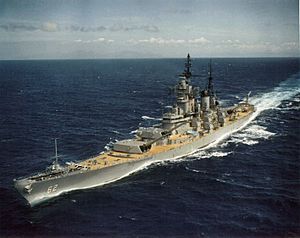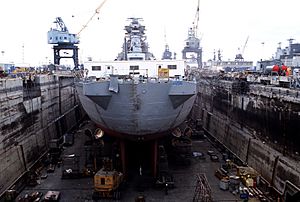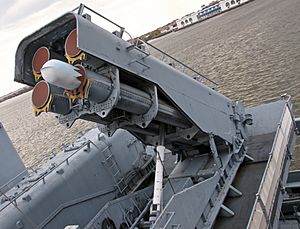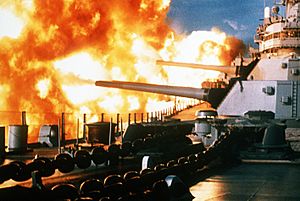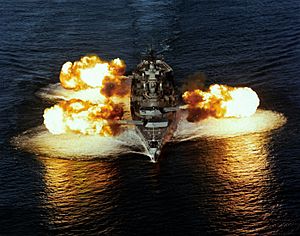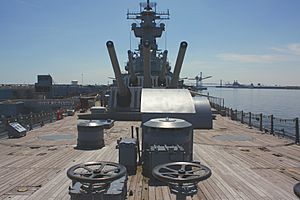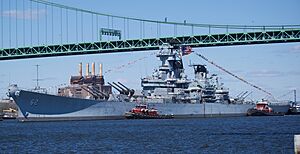USS New Jersey (BB-62) facts for kids

USS New Jersey underway in January 1985
|
|
| History | |
|---|---|
| Namesake | State of New Jersey |
| Ordered | 1 July 1939 |
| Builder | Philadelphia Naval Shipyard |
| Laid down | 16 September 1940 |
| Launched | 7 December 1942 |
| Sponsored by | Carolyn Edison |
| Commissioned | 23 May 1943 |
| Decommissioned | 30 June 1948 |
| Recommissioned | 21 November 1950 |
| Decommissioned | 21 August 1957 |
| Recommissioned | 6 April 1968 |
| Decommissioned | 17 December 1969 |
| Recommissioned | 28 December 1982 |
| Decommissioned | 8 February 1991 |
| Stricken | 4 January 1999 |
| Identification | |
| Motto | "Firepower for Freedom" |
| Nickname(s) | "Big J" "Black Dragon" |
| Honors and awards |
|
| Status | Museum ship |
| Notes | Most decorated battleship in the history of the US Navy |
| Badge |  |
| General characteristics | |
| Class and type | Iowa-class battleship |
| Displacement |
|
| Length | 887 ft 7 in (270.54 m) |
| Beam | 108 ft 1.375 in (32.95333 m) |
| Draft | 37 ft 9 in (11.51 m) (full load) 41 ft 0 in (12.50 m) aft, 39 ft 0 in (11.89 m) forward (1968) |
| Propulsion | 4 x 53,000 hp turbines powered by 8 x 650 psi m type boilers |
| Speed | 33 knots (61 km/h) |
| Complement | 1,921 officers and men |
| Sensors and processing systems |
|
| Electronic warfare & decoys |
|
| Armament |
|
| Armor |
|
| Aircraft carried |
|
The USS New Jersey (BB-62) is a famous battleship from the United States Navy. She is part of the Iowa class, known for being very powerful ships. People often called her "Big J." This ship earned more battle stars for fighting than any other Iowa-class battleship. She was also the only U.S. battleship to help troops on land during the Vietnam War.
During World War II, New Jersey fired her huge guns at targets on islands like Guam and Okinawa. She also protected aircraft carriers as they launched planes. Later, in the Korean War, she helped with attacks along the North Korean coast. After this, she was put into a special storage fleet called the "mothball fleet."
New Jersey was brought back into service for a short time in 1968 to support U.S. troops in Vietnam. Then, she returned to the mothball fleet in 1969. In the 1980s, she was reactivated again as part of a plan to build a larger Navy. She was updated with missiles and served once more. In 1983, she took part in U.S. operations during the Lebanese Civil War.
New Jersey was officially taken out of service for the last time in 1991. She had served a total of 21 years in the active fleet. She received many awards, including a Navy Unit Commendation for her service in Vietnam and 19 battle stars for her actions in various wars. This makes her the most decorated battleship in U.S. Navy history. After a short time back in the mothball fleet, she became a museum ship in Camden, New Jersey, opening to the public on October 15, 2001.
Contents
- Building a Mighty Battleship
- World War II Adventures (1943–1945)
- Post-World War II Service (1946–1950)
- The Korean War (1950–1953)
- After the Korean War (1953–1967)
- The Vietnam War (1967–1969)
- After Vietnam (1969–1982)
- Reactivation in the 1980s
- Lebanese Civil War (1983–1984)
- Later Years (1984–1990)
- Museum Ship (1991–Present)
- Awards and Honors
- See also
Building a Mighty Battleship
New Jersey was designed in 1938 as a "fast battleship." She was launched on December 7, 1942, which was exactly one year after the attack on Pearl Harbor. She officially joined the Navy on May 23, 1943. She was the second Iowa-class ship to be commissioned. Carolyn Edison, the wife of New Jersey's Governor, christened the ship.
New Jersey had nine massive 16-inch (406 mm) guns in three turrets. These guns could fire heavy shells weighing 2,700 pounds (1,225 kg) over 23 miles (42.6 km)! She also had twenty 5-inch (127 mm) guns for other targets. To protect against air attacks, she was equipped with many 20 mm and 40 mm anti-aircraft guns.
When she was reactivated in 1968, her smaller anti-aircraft guns were removed. She was set up to be a powerful bombardment ship. In 1982, she was updated again. Some of her 5-inch guns were removed to make space for modern weapons. She received four Phalanx Close-In Weapon System (CIWS) mounts to defend against missiles and aircraft. She also got launchers for 32 Tomahawk missiles and 16 Harpoon missiles.
The main deck of New Jersey was made of 53,000 square feet of teak wood. President Franklin D. Roosevelt chose the name New Jersey to thank Governor Charles Edison for his support in building the Iowa-class ships.
World War II Adventures (1943–1945)
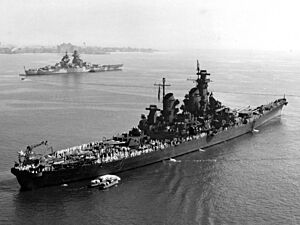
New Jersey trained her crew in the Atlantic and Caribbean. In January 1944, she sailed through the Panama Canal to join the United States Fifth Fleet in the Ellice Islands. She helped with the attack on the Marshall Islands, protecting aircraft carriers as their planes struck Japanese targets.
First Missions in the Pacific
On February 4, 1944, New Jersey became a flagship for Admiral Raymond A. Spruance. Her first big mission was Operation Hailstone, a two-day attack on the main Japanese naval base at Truk. This attack sank many Japanese ships and planes. New Jersey helped sink a Japanese destroyer and fired at enemy aircraft.
She continued to support carrier strikes and bombard enemy positions in the Palaus and Woleai. In April 1944, she provided air support for the invasion of New Guinea and shelled Truk again. Her 16-inch guns destroyed fuel tanks and an airfield on Ponape.
The "Marianas Turkey Shoot"
In June 1944, New Jersey helped prepare for the invasion of the Mariana Islands. Her big guns hit Saipan and Tinian before the Marines landed. When the Japanese fleet tried to stop the invasion, New Jersey protected the carriers during the Battle of the Philippine Sea. This battle became known as the "Marianas Turkey Shoot" because American pilots shot down about 400 Japanese planes, while losing very few of their own. New Jersey's anti-aircraft fire helped keep the American ships safe.
Serving with Admiral Halsey

In August 1944, New Jersey became the flagship for Admiral William F. Halsey Jr. and the United States Third Fleet. For the next eight months, she supported Allied forces in the Philippines, Okinawa, and Formosa. Her task force attacked airfields, ships, and shore bases.
During the Battle of Leyte Gulf in October 1944, New Jersey's planes attacked Japanese forces. Later, she helped defend against kamikaze attacks. She shot down one plane that hit Intrepid and helped defend other carriers.
In December 1944, New Jersey survived Typhoon Cobra, a massive storm that sank three destroyers and damaged many other ships. She returned to port largely unharmed.
Final World War II Missions
From December 1944 to January 1945, New Jersey continued to guard carriers as they struck targets in Formosa, Okinawa, and Indo-China. In January 1945, she became the flagship for Rear Admiral Oscar C. Badger II. She supported the attack on Iwo Jima and the first major carrier raid on Tokyo.
New Jersey was heavily involved in the invasion of Okinawa from March to April 1945. She protected carriers from air raids, rescued downed pilots, and fought off kamikazes. She also used her big guns to prepare the invasion beaches. After the war ended, she sailed to Tokyo Bay in September 1945 and later brought nearly a thousand troops home to San Francisco.
Post-World War II Service (1946–1950)
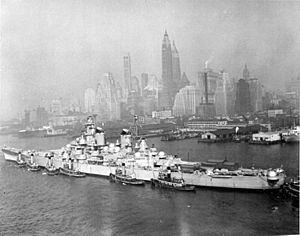
After some operations and repairs, New Jersey returned home to Bayonne, New Jersey, in May 1947. That summer, she was part of a training squadron that visited Northern Europe. She hosted official receptions in cities like Oslo, Norway, and Portsmouth, England.
In 1948, New Jersey was taken out of active service and placed in the "mothball fleet" at Bayonne.
The Korean War (1950–1953)
When North Korea invaded South Korea in 1950, the United States and the United Nations stepped in. New Jersey was called back into service from the mothball fleet to provide powerful artillery support from the sea. She was recommissioned on November 21, 1950.
First Tour of Duty
New Jersey began firing her guns in Korea on May 20, 1951, at Wonsan. Her huge 16-inch guns could hit targets far beyond what land artillery could reach. She moved quickly between targets, supporting ground troops, cutting off enemy supply routes, and destroying enemy positions. During this first mission at Wonsan, she was hit by a shore battery, resulting in one crew member killed and two wounded.
She pounded targets near Yangyang and Kansong, destroying ammunition dumps and railroad facilities. She also helped United Nations troops push back the enemy, hitting mortar positions and supply dumps. On July 28, she silenced enemy shore batteries at Wonsan.
In August, New Jersey supported Republic of Korea troops, firing at enemy positions and breaking up counterattacks. She also took part in a demonstration behind enemy lines to ease pressure on the troops. Her helicopters helped spot targets, leading to the destruction of many buildings and railroad tracks.
Second Tour of Duty
After an overhaul, New Jersey began her second tour in Korea in March 1953. She relieved her sister ship, Missouri, as the flagship of the 7th Fleet. On April 12, she shelled Chongjin, hitting the main communications building. She also hosted the President of South Korea and the American Ambassador.
New Jersey continued to hit coastal batteries, railway tracks, and tunnels. At Songjin, she scored direct hits on a railroad tunnel and knocked out two rail bridges. She provided artillery support for a major air and surface strike on Wonsan, destroying eleven Communist shore guns.
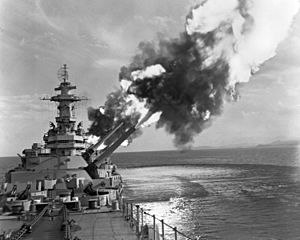
On her tenth birthday, May 23, 1953, she celebrated in Incheon with important guests. She then returned to action, knocking out harbor defenses and gun emplacements. Her guns destroyed five gun positions, an observation post, and supporting trenches at Kosong.
In July, New Jersey carried out one of her most intense bombardments at Wonsan, destroying many enemy guns, caves, and tunnels. She also hit radar control positions and bridges. Her gunners were very accurate, destroying bunkers, artillery areas, and observation posts. Her last mission was at Wonsan, where she destroyed large-caliber guns and trenches. Two days later, she learned of the truce.
After the Korean War (1953–1967)
After the Korean War, New Jersey visited Hong Kong and Japan. In September 1953, the President of South Korea presented the Korean Presidential Unit Citation to the 7th Fleet aboard New Jersey.
For the next two summers, she carried midshipmen for training cruises across the Atlantic. In September 1955, she began her first tour with the United States Sixth Fleet in the Mediterranean Sea, visiting cities like Gibraltar and Istanbul. She returned to Norfolk in January 1956. After another training cruise to Northern Europe, she was decommissioned and placed in reserve in August 1957.
The Vietnam War (1967–1969)
In 1967, the U.S. government decided to reactivate a battleship to help with naval gunfire support in Southeast Asia during the Vietnam War. New Jersey was chosen because she was in the best condition. She underwent modernization, where her old anti-aircraft guns were removed, and she received improved electronic systems and radar. She was recommissioned on April 6, 1968. During sea trials, she set a battleship speed record of 35.2 knots (65.2 km/h).
New Jersey left Philadelphia in May and arrived at her new home port of Long Beach, California, in June. She practiced receiving heavy ammunition by helicopter, a new method at the time.
On the Gun Line
On September 2, New Jersey sailed for Vietnam. On September 30, 1968, she fired her first shots in battle in over sixteen years, targeting enemy positions near the Demilitarized Zone (DMZ). She continued to fire at enemy bunkers, supply trucks, and anti-aircraft sites. On October 7, she sank eleven enemy supply boats.
New Jersey pounded coastal installations and truck concentrations. For three days in October, she shelled the heavily fortified Vinh caves, aiming to clear out enemy forces. She also destroyed a coastal battery on Hon Matt Island.
She supported the U.S. 3rd Marine Division, destroying structures and an artillery site. She also helped the 173rd Airborne Brigade, destroying a command post and bunkers. On October 26, enemy artillery tried to hit New Jersey, but the shells fell short.

New Jersey continued to support ground troops, destroying structures, bunkers, and trench lines. She also silenced an enemy anti-aircraft site. She then moved south to support the U.S. 1st Marine Division near Da Nang.
In November, she supported the 173rd Airborne Brigade, destroying bunkers and structures. She carried out one of her most destructive bombardments, hitting enemy storage areas near Quảng Ngãi, destroying many structures and bunkers. She also supported the 101st Airborne Division and the Army of the Republic of Vietnam 47th Regiment.
In January and February 1969, New Jersey continued to support Marines and the Korean 2nd Marine Brigade. She fired 16-inch shells into tunnels and bunkers. On February 22, she responded to an urgent request for fire support from the besieged Oceanview observation post, helping to repel an attack.
By March 1969, New Jersey had fired 5,688 rounds of 16-inch shells and 14,891 rounds of 5-inch shells during her Vietnam tour.
After Vietnam (1969–1982)
After her Vietnam tour, New Jersey sailed for Japan. Her return home was delayed when North Korean jet fighters shot down an unarmed U.S. surveillance plane. New Jersey was ordered back to Japan in case of further conflict, but the crisis eased.
She finally arrived at Long Beach, California, in May 1969. However, due to budget cuts, New Jersey was chosen to be inactivated again. On December 17, 1969, she was decommissioned and returned to the inactive fleet. Her commanding officer said, "Rest well, yet sleep lightly; and hear the call, if again sounded, to provide fire power for freedom."
Reactivation in the 1980s
In the early 1980s, President Ronald Reagan wanted to build a 600-ship Navy. New Jersey was chosen for reactivation in 1981. She was towed to Long Beach Naval Shipyard for a major modernization.
The Navy planned to use New Jersey and her sister ship Iowa to meet global needs. They decided to update the battleships with cruise missiles and anti-ship missiles. On December 28, 1982, New Jersey was officially recommissioned at Long Beach, California. This marked the return of battleships to active service after 13 years.
New Jersey received advanced weaponry. This included launchers for 16 Harpoon missiles (anti-ship missiles) and 32 Tomahawk missiles (cruise missiles). She also got four Phalanx Close in Weapon System (CIWS) guns for defense against missiles and aircraft. She was equipped with RQ-2 Pioneer Unmanned Aerial Vehicles (drones) to spot for her big guns, replacing helicopters. Her radar and fire control systems were also upgraded.
Because New Jersey had been reactivated for the Vietnam War, her modernization was a bit different from her sister ships. Her 20 mm and 40 mm anti-aircraft guns had already been removed, which saved time and money. The main change was adding the missile launchers and new electronic systems.
Lebanese Civil War (1983–1984)
In 1983, a civil war was happening in Lebanon. A Multinational Force, including U.S. Marines, was sent to help restore peace. In August 1983, U.S. Marine positions near Beirut were attacked. The U.S. government decided to send New Jersey to the region.
On September 16, 1983, New Jersey arrived. Her presence helped reduce attacks on the Marines. On December 14, New Jersey fired her 16-inch guns at hostile positions inland of Beirut. These were the first 16-inch shells fired in combat anywhere in the world since her Vietnam service in 1969. This was in response to attacks on U.S. reconnaissance planes.
On December 24, 1983, entertainer Bob Hope performed a Christmas show aboard New Jersey for the crew and Marines. On February 8, 1984, New Jersey fired almost 300 shells at positions in the hills overlooking Beirut. This was the heaviest shore bombardment since the Korean War.
Some people discussed the effectiveness of New Jersey's gunfire. An investigation found that some shells missed their targets by a large distance. This was believed to be due to issues with the gunpowder used. The problem was later resolved with new powder supplies.
Later Years (1984–1990)
In 1986, New Jersey began her next deployment as the main ship of her own battle group in the Pacific. She sailed from Hawaii to Thailand, allowing aircraft carriers to focus on other missions. She was the only major U.S. naval presence in the region for several months.
In 1988, after repairs, New Jersey returned to the Pacific. She operated near Korea before the 1988 Summer Olympics in Seoul, South Korea, and then went to Australia for bicentennial celebrations.
In April 1989, her sister ship Iowa had a serious explosion in one of its gun turrets. This led to a temporary ban on live-fire exercises for battleship guns. The ban was later lifted. New Jersey's final cruise began in 1989, taking her through the Indian Ocean and into the Persian Gulf. She returned to the United States in February 1990.
Museum Ship (1991–Present)
|
USS New Jersey (BB-62)
|
|
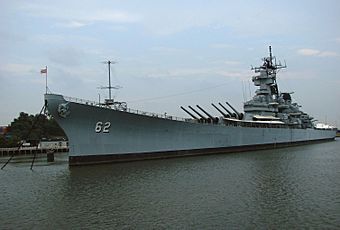
Overview of the ship from a river ferry
|
|
| Location | 62 Battleship Place Camden, New Jersey |
|---|---|
| Built | 1942 |
| Architect | U.S. Navy |
| NRHP reference No. | 04000980 |
| Added to NRHP | 17 September 2004 |
With the end of the Cold War in the early 1990s, defense budgets were cut. The high cost of keeping battleships active became too much. So, New Jersey was decommissioned for the last time on February 8, 1991. She had served a total of 21 years, more than any other Iowa-class battleship. This meant she could not participate in Operation Desert Storm in 1991, where her sister ships Missouri and Wisconsin fired Tomahawk missiles at Iraqi targets.
New Jersey was towed to Bremerton, Washington, and remained in reserve until 1995. Later, a law required two Iowa-class battleships to be kept in the reserve fleet in good condition. New Jersey was chosen, along with Wisconsin, because she was in better shape than Iowa.
In 1999, another law allowed New Jersey to be transferred to a non-profit group to become a museum ship in New Jersey. In September 1999, she was towed from Bremerton to Philadelphia for restoration.
Two groups wanted to host the battleship as a museum. The Navy chose the Home Port Alliance of Camden, New Jersey. On October 15, 2000, New Jersey arrived at her final home on the Camden Waterfront.
Open to the Public
Soon after her arrival, New Jersey opened to the public as the Battleship New Jersey Museum and Memorial. Visitors can take self-guided tours, guided group tours, and even sleep overnight in the original berths. These overnight stays are popular with groups like Scouting organizations.
New Jersey has been recognized for her historical importance. In 2004, the State of New Jersey officially named her an historical place. She was also added to the National Register of Historic Places that same year.
One of New Jersey's original gun barrels is on display in Philadelphia, another next to the ship in Camden, and a third in Basking Ridge, New Jersey. A propeller is displayed in Colts Neck, New Jersey. The museum also has a YouTube channel that shares facts and history about the ship.
In the spring of 2024, New Jersey went into dry dock for important preservation work. This was the first time she had been in dry dock since her decommissioning. Workers cleaned and repainted her hull, repaired leaks, and reinforced thin sections of steel. This work ensures the ship will be preserved for many more years.
Awards and Honors
New Jersey earned nine battle stars for her service in World War II, four for the Korean War, three for the Vietnam War, and three for actions in Lebanon and the Persian Gulf. She also received the Navy Unit Commendation for Vietnam and Lebanon, and Presidential Unit Citations from the Philippines and South Korea. These awards make New Jersey the most decorated battleship in U.S. history.
| Combat Action Ribbon with 1 star |
Navy Unit Commendation with 1 star |
Navy E Ribbon with 2 Battle Es |
Navy Expeditionary Medal |
| China Service Medal | American Campaign Medal | Asiatic-Pacific Campaign Medal with 9 battle stars |
World War II Victory Medal |
| Navy Occupation Service Medal with "ASIA" clasp |
National Defense Service Medal with 2 stars |
Korean Service Medal with 4 battle stars |
Armed Forces Expeditionary Medal with 1 star |
| Vietnam Service Medal with 3 stars |
Navy Sea Service Deployment Ribbon with 3 stars |
Philippine Presidential Unit Citation | Korean Presidential Unit Citation |
| Vietnam Cross of Gallantry | Philippine Liberation Medal with 2 stars |
United Nations Korea Medal | Vietnam Campaign Medal |
See also
 In Spanish: USS New Jersey (BB-62) para niños
In Spanish: USS New Jersey (BB-62) para niños
- List of museum ships





